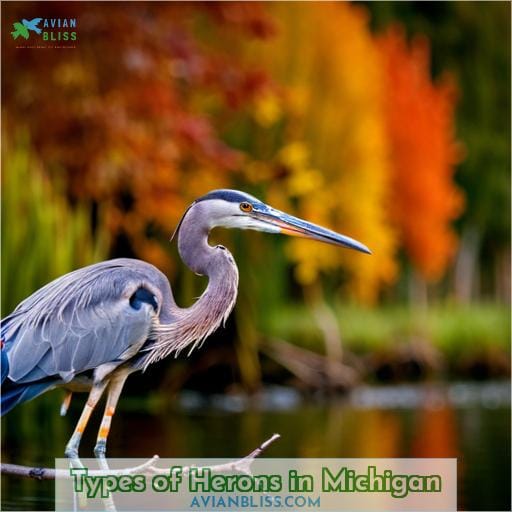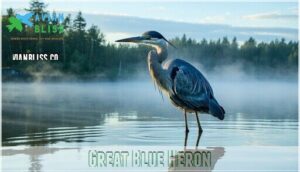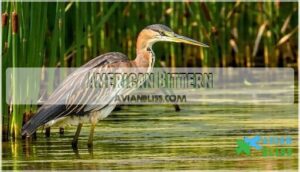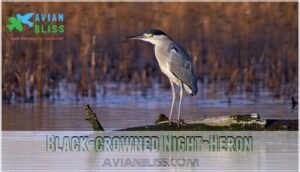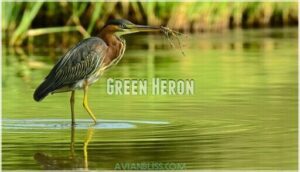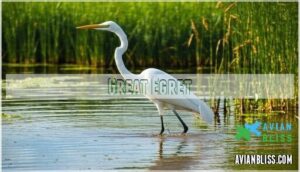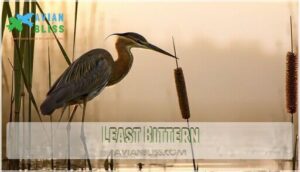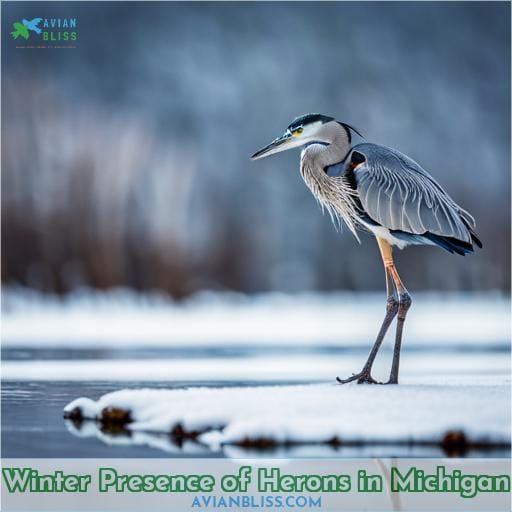This site is supported by our readers. We may earn a commission, at no cost to you, if you purchase through links.
1
We’ll cover range maps and preferred habitats since that info helps narrow down what herons you’ll actually see. Some like Great Egrets stick out brightly against the landscape, while Least Bitterns blend into reeds.
There are rewarding moments ahead as your skills improve – like the first time a Green Heron emerges from foliage at a favored pond’s edge.
As we review descriptions and range maps, your new knowledge empowers exciting discoveries.
Table Of Contents
- Key Takeaways
- Types of Herons in Michigan
- Great Blue Heron
- American Bittern
- Black-crowned Night-Heron
- Green Heron
- Great Egret
- Cattle Egret
- Least Bittern
- Other Heron Species in Michigan
- Winter Presence of Herons in Michigan
- Frequently Asked Questions (FAQs)
- What is the significance of heron colonies in Michigan’s ecosystems?**
- How do herons communicate with each other, both within their species and across different heron species?**
- What are the key threats to heron populations in Michigan and how are conservation efforts addressing these challenges?**
- Can you elaborate on the unique tools that Green Herons use for hunting in wet habitats?**
- What are some lesser-known behaviors exhibited by herons during the winter months when they are present in Michigan?**
- Conclusion
Key Takeaways
- Explore elegant, long-legged waders inhabiting Michigan.
- Understand the art of identifying herons through distinct features and calls.
- Highlight essential details for distinguishing different heron species.
- Appreciate the beauty and diversity of heron species in Michigan.
Types of Herons in Michigan
You will witness wonderful waterbirds with wily ways while wandering wetlands. Michigan’s diverse wetlands host magnificent herons during summer.
Observe the long-legged great blue heron standing statue-still before spearing fish.
Listen for the croak of the elegant white great egret.
Search through reeds to spot the secretive least bittern’s chestnut and black plumage.
Marvel at the green heron’s tool use while hunting frogs.
Enjoy the black-crowned night-heron’s nocturnal squawks by moonlight.
Though most herons migrate south for winter, some remain, adapting their feeding and breeding in the cold months.
Michigan’s wetlands provide essential habitat for these avian wonders.
Explore more to appreciate the ecology and beauty of herons in the Great Lakes State.
Great Blue Heron
You’ll often spot the Great Blue Heron standing motionless along the edges of lakes and wetlands as you explore Michigan’s diverse habitats. This large bird can be identified by its blue-gray plumage, black stripe over the eye, and habit of hunting alone for fish, frogs, and other prey.
Range Map
Delve into the geographical distribution of these avian species by examining their respective range maps. Michigan’s wetlands support diverse heron colonies, though conservation efforts preserve vulnerable breeding grounds.
Climate adaptability allows year-round residence for some, like the Great Blue, while others migrate south when marshes freeze. Seek documented sightings to photograph these graceful waders before they disperse from summer nesting grounds.
Habitat and Behavior
The Great Blue Heron stalks wetlands and waterways alone, spearing fish and frogs with its dagger-like bill. As a wetland bird, it is vulnerable to habitat destruction, needing healthy marshes and swamps for feeding, breeding, and nesting locations.
Conservation efforts to protect wetlands benefit the blue heron and related species like the reddish, snowy, and yellow-crowned night heron.
YouTube Channel
Check out ‘Pure Michigan Birds’ on YouTube to enjoy all of Michigan’s diverse bird species, especially beloved herons.
- See pictures and videos of herons in their natural habitats.
- Hear the calls and sounds of different heron species.
- Learn interesting stories and facts about each type of heron.
- Discover the best places to find herons across Michigan.
Enjoy learning more about Michigan’s amazing herons on this informative channel.
American Bittern
You’ll have to stay quiet if you hope to spot an American Bittern’s subtle camouflage in the cattails. This secretive heron has streaked brown plumage that conceals it among reeds and utilizes flexible hunting strategies to capture prey.
Though mainly nocturnal, its hoarse oong-KA-chunk call may sound through marshes at dawn and dusk.
While great blue herons and yellow-crowned night-herons prefer to nest colonially in trees, the solitary American Bittern builds platform nests concealed in shrubs over water. Summer marshes and wetlands with dense vegetation provide the ideal habitat for this wary heron to forage by day.
Using slow movements and inconspicuous postures, bitterns stealthily stalk frogs, fish, and insects. Patience and luck are required to observe an American Bittern before it fades into its surroundings once again.
Black-crowned Night-Heron
You may observe the Black-crowned Night-Heron’s nocturnal feeding habits and breeding vocalizations when encountering this species in Michigan wetlands. This stocky heron hides in reeds by day but comes alive at twilight. As the sun sets, listen for its distinct squawking rising from the marsh as the birds leave their nests to forage.
Though black-crowned night-herons breed in Michigan, those that don’t often migrate south for winter. Non-breeding individuals still found here are probably vagrants. Like their great blue cousins, night-herons stalk frogs, fish, and insects.
Right before dusk, watch them perch and wait patiently to ambush prey. Their skill evolved to perfection over millions of years.
Soon they’ll slip away with the fading light, but tomorrow this dance begins anew.
Green Heron
Foraging with tools, the medium-sized green heron occupies wet habitats in Michigan. As you spot this solitary hunter standing motionless along the water’s edge, watch for its specialized feeding behaviors.
The green heron exhibits one of the most diverse foraging repertoires of any heron, using insects, twigs, or feathers as bait. Though populations are stable, the species is threatened by the loss of wetland habitat.
Conservation efforts should focus on protecting undisturbed nesting and foraging grounds. Breeding sites include small wetlands, flooded fields, and vegetation along streams. With its olive-green plumage, slender yellow legs, and wispy crown plume, the green heron blends into its surroundings.
Observe patiently, and you may witness this master angler snatching fish and frogs.
Great Egret
The large, elegant Great Egret, rarely breeding in Michigan, can be spotted foraging in shallow waters with its signature croak-like call.
- Habitat selection: Favors shallow water habitats like marshes, streams, ponds.
- Foraging: Patiently stalks prey or stirs up bottom.
- Nesting: Colonies in trees or shrubs near water.
- Migration: Winters along Gulf Coast and farther south.
- Conservation: Protected under Migratory Bird Treaty Act.
During summer, this elegant white heron may wander north to Michigan wetlands. Though a rare nester, its stately presence contributes to the state’s avian diversity. Like other herons, this waterbird fills an important niche in its habitat. Appreciate sightings of these species gracing our state.
With continued conservation, perhaps more will find Michigan suitable for breeding in future summers.
Cattle Egret
You’ve just learned about the Great Egret, a stately white heron that rarely breeds in Michigan.
Now we come to the Cattle Egret, a smaller white heron that exhibits some fascinating behaviors. As the name implies, these egrets often follow and forage near livestock. Their adaptations allow them to thrive in expansive wetlands as well as pastures.
During breeding, they develop a buffy orange hue and nest colonially in trees and shrubs. Outside of breeding, they wander widely. In fact, some dispersing birds turn up on eBird checklists as far north as Michigan, especially in late summer.
Careful wetland conservation provides habitat for species like Cattle Egrets. Observing them interacting with livestock or probing the mudflats can be a delightful experience for a birdwatcher.
Least Bittern
You’ll find the smallest heron in Michigan among the reeds. To identify least bitterns and other herons in your area, listen and look for field marks like coloration and posture as these secretive birds emerge at dawn or dusk.
Smallest Heron in Michigan
You’d hardly notice the tiny Least Bittern concealed in dense reeds. This smallest heron in Michigan may seem insignificant at just twelve inches tall, but it plays a vital role. It hunts frogs, fish, and insects, camouflaged in marsh grasses. With unique adaptations like climbing reeds and hovering in flight, it survives in wetlands unnoticed.
Though elusive, witnessing its arrival each spring reminds us that nature’s smallest creatures have an outsized impact.
Identifying Herons in Your Area
Spotting herons while hiking wetlands allows you to glimpse their hunting and nesting behaviors. Carefully observe their adaptations for standing motionless to ambush prey. Notice their techniques for spearing fish or frogs.
See their interactions with predators like hawks or otters. Capturing images of these elegant birds utilizes online resources to identify species and their facts. Learning about heron distribution and sounds helps appreciate these water-loving birds.
Other Heron Species in Michigan
Great to continue our exploration of Michigan’s diverse heron species. The Black-crowned Night Heron, Snowy Egret, and Yellow-crowned Night-Heron contribute to the state’s avian biodiversity through their unique behaviors, habitats, and seasonal presence.
As an avid birder, you’ll appreciate spotting these waterbirds in their native wetland environments.
Black-crowned Night Heron
Try catching a glimpse of the Black-crowned Night Heron’s unique squawking during its nocturnal breeding in Michigan’s wetlands, but don’t disrupt its natural rhythms. As a lifelong observer, beholding this bird’s remarkable colors and calls connects me with wildlife’s gifts, yet its sensitive nesting habits teach us to tread lightly.
Our wetlands nurture its shrouded mysteries; may we learn to find belonging within Earth’s interconnected family.
Snowy Egret
Between stalking cattails and shuffling through marsh muck, lie still to let a pearly white snowy egret emerge like a ghost amidst the reeds, speaking proverbs of patience.
- Plumage of purest white for camouflage
- Rare sightings in Michigan wetlands
- Habitat loss impacts migration patterns
With patience and protection, snowy egrets may grace Michigan’s marshes more frequently.
Yellow-crowned Night-Heron
You’re likely to glimpse the yellow-crowned night-heron’s striking plumage if you wander the wetlands at dusk. This migrant’s night-adapted vision and varied diet make it a marvel. Restoring wetlands aids species like this nocturnal heron, distinguishable from egrets by its crown’s bold stripes.
Winter Presence of Herons in Michigan
You’ve explored Michigan’s diverse herons inhabiting wetlands and backyards during the warmer months. However, as winter arrives and temperatures plummet, most herons migrate south. The hardy Great Blue Heron and Black-crowned Night-Heron remain, adapting their feeding and nesting strategies.
You may spot a Great Blue Heron ice fishing in frozen lakes or a Black-crowned Night-Heron nocturnally feeding on frogs and fish in unfrozen wetlands. Their nesting sites in trees and shrubs become encrusted in ice and snow. Herons must take care to avoid predators hunting easier targets in winter while they hunt and feed.
Overall, the impact of frozen waterways alters the herons’ typical habits. Yet these species find ways to survive Michigan winters before warmer weather returns their companions.
Frequently Asked Questions (FAQs)
What is the significance of heron colonies in Michigan’s ecosystems?**
Nurturing Michigan’s ecosystems like guardians of aquatic realms, heron colonies shape vibrant tapestries. Their colonial symphony cultivates unity amidst diversity, echoing nature’s grandeur and inviting you to embrace belonging in the wetland mosaic.
How do herons communicate with each other, both within their species and across different heron species?**
Herons employ a repertoire of communication within their species and across others. Vocalizations, such as squawks and calls, convey warnings and territory claims. Visual cues, like displays and postures, establish hierarchy and intent.
What are the key threats to heron populations in Michigan and how are conservation efforts addressing these challenges?**
In the delicate dance of heron conservation in Michigan, the ominous shadow of habitat loss looms large. Wetland degradation and urban sprawl threaten their sanctuaries. Yet, dedicated efforts, from habitat restoration to public awareness, strive to ensure these elegant birds remain Michigan’s avian icons.
Can you elaborate on the unique tools that Green Herons use for hunting in wet habitats?**
Delving into the Green Heron’s ingenious hunting techniques reveals a captivating world. They craft tools from twigs, luring fish with bait. A testament to nature’s artistry, fostering a sense of connection and wonder.
What are some lesser-known behaviors exhibited by herons during the winter months when they are present in Michigan?**
During Michigan’s winters, herons reveal remarkable adaptations. Great Blue Herons and Black-crowned Night Herons stay put, braving the cold. Their fishing tactics shift, targeting ice-free spots, showcasing nature’s resilience in the face of adversity.
Conclusion
Amidst Michigan’s diverse landscapes, the herons stand as avian sentinels, weaving their presence through wetlands and backyards alike. Each species possesses its distinct allure, a living testament to the intricate balance of nature.
As you traverse this avian tapestry, the grand silhouette of the Great Blue Heron graces your vision, while the secretive American Bittern resonates with its oong-KA-chunk call. The Black-crowned Night-Heron emerges from the shadows, a symbol of nocturnal prowess.
In the verdant embrace of wet habitats, the Green Heron’s olive-green elegance beckons, and the Great Egret’s stately white form evokes awe. The Cattle Egret, adorned in white and orange, forms an unexpected partnership with livestock.
Amidst reedy haunts, the elusive Least Bittern leaves an indelible impression, embodying a resilient spirit.
Yet, the heron symphony extends beyond, encompassing the enigmatic Snowy Egret and the vagrant wanderer, the Yellow-crowned Night-Heron. As Michigan’s seasons shift, some herons embark on a southerly journey, while the Great Blue Heron and the steadfast Black-crowned Night-Heron remain as winter’s stoic custodians.
Gazing upon these herons, you glimpse the intricate threads woven into Michigan’s avifauna tapestry. Their habitat choices and behaviors intertwine with the very essence of the land they call home. With binoculars in hand and a heart attuned to nature’s rhythm, you embark on a journey of discovery, an explorer of Michigan’s watery realms and the majestic herons that grace them.
So, venture forth, embrace the tranquil magic, and let the herons of Michigan guide your gaze toward a world of avian wonder.

